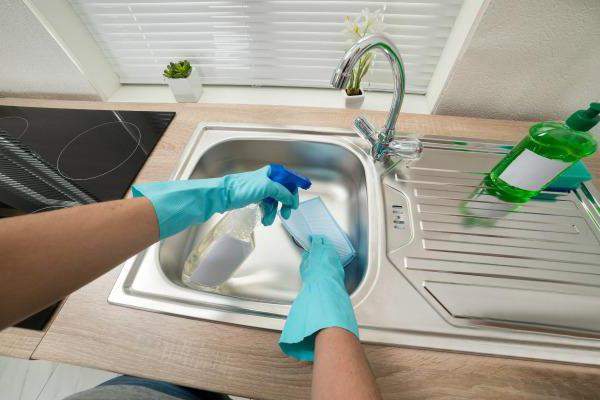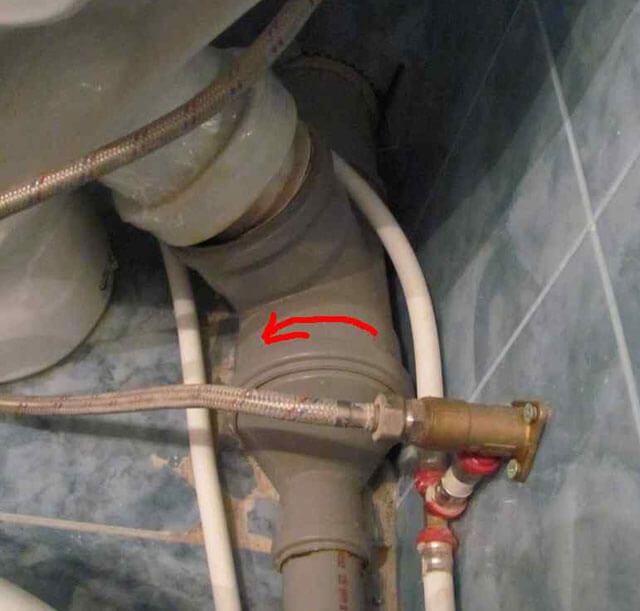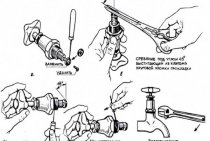Leakage
At the junction of the siphon with the pipe, there is often a violation of tightness. The occurrence of this problem is fairly easy to identify (as opposed to blockages or internal breakdowns), as the result will be leaks. If the problem was not solved at the time of their occurrence, these leaks cause stench from the sink, the appearance of fungus and mold on the walls and floor. This happens when the seals are worn or damaged. A temporary solution may be a special sealing tape or electrical tape, but new seals will help to finally solve the issue.
If a leak has occurred between the pipes, then it is necessary to coat their joints with silicone sealant.
If the sink is clogged or the pipes are damaged
If you checked the correct installation of the structure, and nothing caused you doubts, you can proceed to the next step.
You need to pay attention to the following points:
- Turn on the faucet in the kitchen and watch the water: if it does not drain immediately, but stagnates in the sink, then a blockage has formed. It can be removed in several ways, the most popular of which is the use of a plunger. It is necessary to turn on the water so that the plunger bowl is under water, attach it to the drain hole and make vertical movements. After a few minutes of such actions, you need to tear the plunger from the hole and let the stagnant water drain back, the blockage will be cleared, and the sewer smell will disappear. The second option is to use special cleaning products, they can be bought at a hardware store. The substances that make up their composition dissolve all the plaque that has accumulated on the walls of the pipes, from fat to hair.
- If the water drains normally, you need to check the integrity of the pipes and the correctness of their connection. If the pipe is cracked in some area, it must be replaced, but if the elements of the drain system are simply loosely screwed to each other, they must be fixed.
- If a characteristic squelching is heard from the drain, and there are no signs of structural failure, the riser may be airborne. Only employees of housing and communal services can cope with this, it is impossible to solve this problem on their own.
The problem of the smell of sewage from the sink in the kitchen most often lies in the formation of plaque on the walls of the pipes. The easiest option to get rid of it is to call a plumber who can disassemble and flush all the components of the drain system. But if you don’t want to spend money on his services, you can use improvised means.
If you have a flask siphon installed, you need to unscrew it and clean it. Often an object gets stuck in it, on which other waste is subsequently layered. Thus, by removing all impurities from the pipe, you can easily eliminate the smell from the sink.
There are also folk ways to solve the problem. First, you can eliminate the smell from the sink with baking soda. Three tablespoons of this product should be mixed in a glass of warm water and pour this mixture down the drain. After half an hour, you need to turn on a stream of warm water to get rid of the remnants of the solution in the pipes. Secondly, you can use table vinegar by pouring it into the drain hole, which then needs to be plugged with a rag so that the smell of the product does not spread. Thirdly, you can use citric acid, pour it with boiling water and pour the mixture into the sink, and after half an hour rinse with a stream of warm water.
Non-professional breakdown diagnostics
The first thing to do for this is to flush the pipes. The smell may disappear for a while and then reappear. This is a sure sign that the reasons are not just dirty walls.After that, you can observe the operation of the drain system, for which you must first remove all items from the cabinet under the sink. If the water does not drain immediately, but with some delay, or stagnates in the sink, this is a sign of a blockage. It can be eliminated with a plunger, while it is small, or using special tools, the most professional of which are able to dissolve not only fat, but even human hair. Long-term stagnation in the sink, which is not removed by either method, requires the help of a plumber and the use of special tools.
You can diagnose a breakdown of the sewer system in the sink using improvised means by examining the pipes
If the water drains normally, but makes characteristic squelching sounds, this means that the riser is airy. You should not think about what this means, because a simple kitchen worker cannot overpower this, as well as replacing pipes in case of cracking or depressurization. You need to call your husband, and if he cannot cope with the scope of work, then plumbing. If a flask siphon is installed in the system, then with all its undeniable advantages, it must be periodically unscrewed and cleaned. Perhaps it is its clogging that is the source of unpleasant odors.
An unpleasant smell can also appear if the sink has not been used for a long time, but this disaster is the most easily eliminated - before leaving for some time, pour a little sunflower oil into the sink, and upon arrival, begin to actively use the sink again. This will prevent the possibility of bacterial growth.
How to get rid of the smell from the sink in the kitchen at home
- Use improvised means - salt, soda or vinegar. There is only one principle - leave the concentrated product for 2-5 hours, and then rinse everything with boiling water. The method is effective enough to eliminate greasy deposits on the inner walls of pipes. This procedure must be carried out regularly as a preventive measure to avoid the accumulation of small food residues in the siphon.
- With a faulty water seal and the “seething” and “hissing” of water characteristic of this, the presence of the simplest plumbing skills will help to cope. Which in a matter of hours will even out the slope of the pipes or replace the riser with pipes of a larger diameter to prevent the formation of a vacuum in the system.
- If the cause of the unpleasant odor lay in an unsuccessful model or improper installation of the siphon, then larger equipment is selected or the old one is reconnected. If the thread breaks continue, then they resort to a complete replacement of this part of the drain and the purchase of a new siphon.
Siphon analysis
If the corrugated pipe from time to time began to unbend and cracks formed on it, then the use of insulating tape will be a temporary salvation from troubles. But this is a temporary procedure that will help for a few days before acquiring a new material.
First necessary steps
To eliminate an unpleasant smell, you will have to find its root cause, otherwise it will only be possible to reduce its intensity, but after a while it will grow again. If you look under the sink, you will see that a curved pipe goes down from the sink, in some cases it is smooth, in others it is corrugated. This pipe is called a siphon, its design allows you to keep the sewer smell from passing through the sink into your kitchen, but if it does pass, it means that there is a problem in some part of the pipe.
Regardless of which siphon you have installed - bulb or corrugated - the principle of their operation is the same. They should always contain the required amount of water, it just plays the role of a sewer smell blocker. Its absence is the second reason for the smell. Troubleshooting methods depend on what happened to the pipes or siphon, there are several options:
- The corrugated pipe has lost its shape.This is a fairly common problem that can occur even with proper pipe installation. From the very first day of operation, you need to fix it with special holders, so it will be protected from deformation. If you notice that the pipe is sagging, you need to temporarily fix it with electrical tape and purchase a new siphon. After installing it, the unpleasant smell will not bother you.
- An error was made while installing the siphon. Most often, if the pipe is installed independently, assembly rules may not be taken into account. If you have a flask siphon installed, the problem may be in the pipe - one of the elements of the drain system that connects the sink bowl and the siphon. In order to return the dominance of pleasant aromas to the kitchen again, you need to adjust the position of the nozzle, it should be immersed in water by 2-3 cm, but not touch the bottom of the flask.
- Long downtime. If you do not use the sink for several months or years, the water from the siphon evaporates and there is nothing else to hold back unpleasant odors. Removing them from the sink in the kitchen in this case is very simple, you just need to drain more water into the sink, and after a while the liquid will do its job. If you know in advance that you will not use the sink for a long time, you need to drain a little sunflower oil into it before leaving, which will create a film that protects the water from evaporation.
Often the cause of problems with the sink in the kitchen is the self-installation of the drain system. If you've never done it, it's best to let a professional plumber oversee it so you can get it right afterwards. In most cases, problems arise with corrugated siphons, so if you have one, it is recommended that you call a plumber to install the system. This will protect you not only from the possibility of a sewer smell, but also from more serious problems, such as a spill.
Causes of bad odors
There can be many root causes, but the main one is clogging of the siphon. This is the small curved part of the sewer that sits directly below the sink. Serves to maintain the water level in the bend and separate the air in the apartment and in the sewer pipe. Regardless of the design, all siphons work the same way.
Standard siphon
Usually, in pipes or siphon, after a while, with insufficient care for the system, a greasy coating forms, on which small particles of food waste stick.
Accumulation of food debris in the drain
In addition to the classic reasons, blockages and unpleasant odors can be caused by malfunctions of the siphon itself, high wear and cracking of plastic pipelines, loosening of the threads of the connections, disruption of the water seal, holes in metal pipes, and an improperly designed drain system under the sink.
Plaque in the plum
Related article:
Possible mounting errors
Errors during the installation of siphons can be as follows:
- The nozzle is not properly submerged in water. This oversight is very common, because of this, an unpleasant odor enters the room through the space between the walls of the siphon and water.
- Stretching when installing a corrugated pipe. Negligence can also be tolerated by plumbers who do not have very good skills.
- Shortened siphon baffle. This causes the water seal to be too small, it breaks periodically and the water leaves. There is only one way to solve this problem - to replace the siphon.
- The corrugated pipe is bent. In such a situation, you can bring it to its normal position and fix it with electrical tape. But this is only a temporary measure, in the future you need to buy a new pipe.
- Incorrect installation of the siphon (for example, upside down).
- Lack of plumbing. Prolonged stagnation of water can cause evaporation of water stagnant in the siphon.Namely, this liquid, which is constantly present in the device, does not allow bad odors to enter the room from the sewer.
It is these situations that are usually the main causes of the formation of an unpleasant odor. Pollution of pipes can occur even with a short operation of the pipeline. In these situations, not only a slight coating is formed on it, but also real traces of decay and mold in the system, as well as various manifestations of bacterial activity.
An unpleasant smell from the pipes in the bathroom can also occur if the diameter of the riser is too small. According to the standards, it must be at least 11 centimeters. If this value is less, the passage of drains may be difficult, and this will cause blockages, which, in turn, will lead to unpleasant amber.



